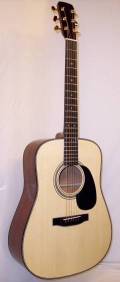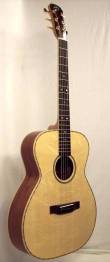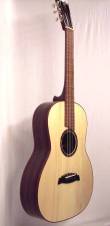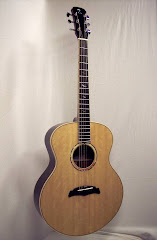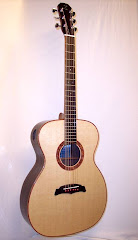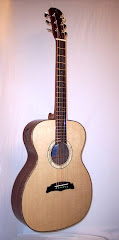I was able to get the remainder of the top braces glued up yesterday for the first top. Today I took it out of the go bar deck and gave it a tap. I was absolutely amazed at the tone I was getting out of a top that had
un-carved braces on it. I got a nice ring, like a bell all over the top with a pretty good sustain. Of course it will change with carving but that was very encouraging. I go the braces all cut for the second top and glued up the X braces and tone bars. Today I glued up the A braces, transverse brace and finger braces. I also cut the two bridge plates which need to be glued on yet.
I then turned my attention to carving the braces on the first top. I decided that the first one will be scalloped with rounded tops and peaks, and the second will be parabolic. With the scallops, I decided to try to be a little systematic in where to put the scallops. I know that the sounds radiate out in circles around the center of the guitar. Those circles have a different diameter based on what note is played. So, instead of randomly cutting scallops where they look right, I decided to mark points on each brace that would put the scallops in a pattern so no two scallops will be in the same circle. I hope that makes sense. Anyways, I used the center of the X braces as a pivot point, then took a string and marked a scallop at the farthest spot out, then shortened the string about 1" and marked the second scallop on a different brace. I did this over and over again until I had every scallop marked on a the braces. I carved them out with a chisel and then sanded them down. I am getting a really nice tap tone which is about the same note as the original tap, but the sustain is much longer, and there are deep overtones. I don't know if this will do anything, but both of these guitars are somewhat experimental so I am interested in seeing how it sounds.
I then
drilled out the top of the A brace for the truss rod wrench access by starting with a tiny bit and then upping the bit sizes until I had the size I wanted. I was a little worried about drilling this hole as I was drilling down the center of a mitre joint. I was afraid that the joint would split right down the middle but it didn't. One down, one to go!

This is the first top (red and
bubinga rosette) in the go bar deck with the remainder of the braces glued up.

The first top with the ends of the braces carved down to the top wood.

Here you can see "X"s on the tone bars and cross braces. All of these are in a different circle radius from the center of the X brace. I marked the finger braces after I took this picture.

The braces after rough shaping with a chisel. I know, the scallops mostly look like they line up, but trust me, none of them are the same distance from the X brace center. I measured all of them and recorded the measurements on my plan for future reference.

Here you can see the truss rod access holes. The one through the transverse brace was no big deal, but the one at the top of the A braces was the one that had me worried.

Here is the top braces after being sanded down to 100 grit. I am going to work on the scallop peaks a little to get them a little more 'pointed' but the braces are pretty much to their final shape.

Just another shot of the hole through the a brace intersection. I can see in this picture that I need to clean up the top edges of these braces!

A side shot of the braces.

This is the second top (green and
spalted maple rosette) in the go bar deck with the last braces being glued up. Neither of the bridge plates are glued in yet. Speaking of bridge plates, I decided not to tuck them under the cross braces this time. There is a lot of discussion in the
OLF forums regarding this and I decide to try and keep the contact between the bridge plate and cross braces to a minimum. Again, more experimentation.






















































